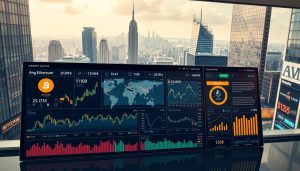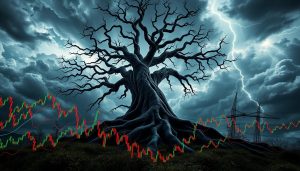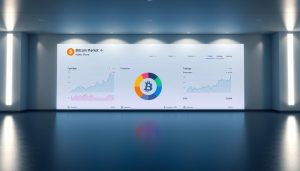You’ve probably heard it a thousand times: “The tokenomics are terrible” or “This project has solid tokenomics.” But what does that actually mean? When you’re looking at a new crypto project, the tokenomics can make or break your investment. It’s not just about whether a token goes up or down, it’s about understanding the economic system that governs the entire project.
Tokenomics is essentially the economic blueprint of a cryptocurrency. It tells you how tokens are created, distributed, and used within an ecosystem. Get this wrong, and even the most promising technology can collapse under poor economic design. Get it right, and you’ll have a project with staying power and real value creation.
The challenge is that most people either ignore tokenomics entirely or get lost in the technical weeds. You need a practical framework that helps you separate the well-designed projects from the ones that are destined to fade. That’s exactly what you’re about to get, a clear, methodical approach to evaluating tokenomics that you can apply to any project you’re considering.
Key Takeaways
- Understanding how to evaluate crypto project tokenomics requires analyzing both supply dynamics and genuine demand drivers that create long-term value.
- Compare circulating supply to total supply and examine vesting schedules—large gaps and short vesting periods signal potential massive selling pressure from insiders.
- Real token utility means the token is required for core platform features, not just optional speculation, creating consistent organic demand.
- Calculate net inflation by comparing emission rates to burn rates; sustainable projects typically have emissions under 10% annually with decreasing schedules.
- Evaluate team and investor allocations carefully—when insiders control more than 40-50% or sit on massive returns, significant sell pressure often follows unlock periods.
- Benchmark your project’s tokenomics against 3-5 successful competitors in the same category to identify red flags or innovative improvements.
Understanding the Basics of Tokenomics

Before you can evaluate anything, you need to know what you’re looking at. Tokenomics combines two concepts: token and economics. It’s the study of how a cryptocurrency works within its ecosystem, how it’s created, distributed, and what drives its value.
Think of tokenomics as the monetary policy of a crypto project. Just like a central bank decides how much money to print and how to distribute it, a crypto project’s tokenomics determines how many tokens exist, who gets them, and what incentives drive people to hold or use them.
At its core, tokenomics should answer several fundamental questions. How many tokens will ever exist? How are they being released into circulation? What can you actually do with the token? Who controls the largest portions of the supply? These aren’t just academic questions, they directly impact whether a token will gain or lose value over time.
You also need to understand that good tokenomics align incentives. When a project designs its token economy well, it creates a system where users, developers, and investors all benefit from the project’s success. When tokenomics are poorly designed, you end up with misaligned incentives where early insiders dump on retail investors or where there’s no real reason to hold the token long-term.
The key is to approach tokenomics with a critical eye. Don’t accept the whitepaper at face value. Look for the underlying mechanisms that will drive real supply and demand dynamics. That’s where the truth lives.
Analyzing Token Supply and Distribution
Supply dynamics are where most people start their tokenomics analysis, and for good reason. The supply structure tells you how scarce a token is and how that scarcity might change over time.
Total Supply vs. Circulating Supply
You’ll encounter several supply metrics when researching a project. Total supply refers to all tokens that will ever exist, including those locked up or not yet minted. Maximum supply is the hard cap, the absolute limit of tokens that can ever be created. Circulating supply is what matters most for immediate price action because it represents tokens actively available in the market.
Here’s where things get interesting. A low circulating supply with a high maximum supply means significant dilution is coming. If only 10% of tokens are currently circulating and the other 90% will be released over the next few years, you’re looking at massive selling pressure down the road. That’s not necessarily a dealbreaker, but you need to know what you’re getting into.
Compare the circulating supply to the total supply. A huge gap between these numbers should raise questions. When is the rest being released? Under what conditions? This brings us to the next critical element.
Token Allocation and Vesting Schedules
How tokens are distributed at launch tells you who has power and who might be incentivized to dump. Look for the breakdown between team, investors, advisors, community rewards, ecosystem development, and public sale participants.
A red flag is when the team and early investors control more than 40-50% of the total supply. Even with vesting schedules, that’s a lot of concentrated power. You want to see meaningful allocation to the community and ecosystem development, these portions fund growth and create long-term value.
Vesting schedules matter enormously. A proper vesting schedule locks up team and investor tokens for a period, then releases them gradually. You’re looking for cliff periods (no tokens released for the first 6-12 months) followed by linear vesting over 2-4 years. Short vesting periods or immediate unlocks are serious warning signs. They suggest the team wants to cash out quickly rather than build something lasting.
Check the project’s documentation for unlock schedules. Some projects publish transparent vesting dashboards that show exactly when tokens unlock. If this information is hard to find or deliberately vague, that’s a problem. Transparency in token distribution is non-negotiable for serious projects.
Evaluating Token Utility and Demand Drivers
Supply is only half the equation. Without real demand drivers, even the scarcest token will languish. You need to understand what creates genuine demand for the token beyond speculation.
Use Cases Within the Ecosystem
The first question is simple: what does the token actually do? This is where many projects fall apart. If the only use case is “you can hold it and hope it goes up,” that’s not utility, that’s just speculation.
Real utility means the token is required to use the platform’s core features. In DeFi protocols, tokens might be needed to pay transaction fees, provide liquidity, or access certain services. In gaming projects, tokens could be required for in-game purchases or breeding new assets. In infrastructure projects, tokens might pay for computational resources or data storage.
The stronger the utility, the more organic demand the token will have. You want to see use cases where people need to acquire and hold tokens to participate in the ecosystem. Pay attention to whether the utility is mandatory or optional. Optional utility is weak, users can simply ignore the token. Mandatory utility creates consistent buying pressure.
Also consider whether the utility is sustainable. Some projects create artificial utility that doesn’t make economic sense. If the token is required for a service that could easily be paid for with stablecoins or other tokens, the utility is fragile. You’re looking for cases where the token is genuinely integrated into the protocol’s architecture.
Staking, Governance, and Additional Benefits
Many projects add demand drivers beyond core utility. Staking is one of the most common, users lock up tokens to earn rewards or participate in network security. This reduces circulating supply and can create upward price pressure, assuming the rewards aren’t inflationary.
Governance rights give token holders a say in protocol decisions. This can be valuable if the protocol is generating real revenue or making meaningful decisions. But governance alone isn’t enough to sustain a token. You need other demand drivers working in concert.
Look for revenue-sharing mechanisms. The best projects distribute a portion of protocol fees to token holders. This creates direct economic value and gives you a reason to hold long-term. Projects like this function more like equity, where you’re entitled to a share of the project’s success.
Some projects offer tiered benefits based on how many tokens you hold, access to exclusive features, reduced fees, or priority services. These can be effective demand drivers if the benefits are genuinely valuable and the tiers are structured reasonably.
Assessing Inflation and Emission Rates
Even if a project has solid utility, high inflation can destroy value faster than demand can create it. You need to understand how new tokens enter circulation and at what rate.
Emission rate refers to how quickly new tokens are minted and distributed. This happens through mining rewards, staking rewards, liquidity mining programs, or ecosystem grants. High emission rates create selling pressure as recipients typically sell at least some of their rewards.
Do the math on annual inflation. If a project is emitting 20% new tokens per year, demand needs to grow by at least 20% just to maintain the current price. That’s a high bar. Sustainable projects typically have emission rates under 10% annually, declining over time.
Look at the emission schedule over multiple years. Does it decrease over time, creating increasing scarcity? Or does it remain constant or even increase? Decreasing emissions are generally healthier because they create a known path toward lower inflation.
Some projects front-load emissions to bootstrap growth and community participation. This isn’t inherently bad, but you need to know when those high-emission periods end. If you’re entering during a period of maximum emissions, you might be buying into maximum sell pressure.
Compare emission rewards to actual protocol usage and revenue. If a project is paying out millions in token rewards but only generating thousands in real revenue, that’s unsustainable. The rewards are essentially being subsidized by token holders through dilution. Eventually, this catches up with the price.
You also want to understand who receives emissions. Are they going to users providing real value, like liquidity providers or network validators? Or are they going to insiders through development funds with minimal accountability? The distribution of emissions matters as much as the rate.
Examining Token Burns and Deflationary Mechanisms
The counterbalance to emissions and inflation is token burning, permanently removing tokens from circulation. This can create deflationary pressure that supports token value over time.
Token burns work by sending tokens to an address where they can never be recovered, effectively reducing total supply. The best burns are built into the protocol’s core operations rather than being one-time events. You want systematic burns that happen automatically as the protocol is used.
Look for burns tied to protocol revenue or usage. Some projects burn a percentage of transaction fees. Others burn tokens when certain actions are performed, like creating NFTs or executing trades. These mechanism create a direct relationship between protocol growth and token scarcity.
The burn rate should be transparent and verifiable on-chain. Any project serious about deflationary mechanics will make it easy for you to track how many tokens have been burned and at what rate. If you can’t easily verify burns, be suspicious.
Compare the burn rate to the emission rate. A project emitting 15% annually but only burning 2% is still highly inflationary. The net inflation rate is what matters for long-term token value. You’re looking for projects where burns can eventually match or exceed emissions, creating net deflation as the project matures.
Some projects announce periodic manual burns, often using treasury funds or buyback programs. These can support price in the short term, but they’re less reliable than automated burns. Manual burns depend on team decisions and available funds, while automatic burns are guaranteed by code.
Be wary of projects that emphasize burning as their primary value proposition. Burning alone doesn’t create value, it just redistributes existing value across fewer tokens. You need burns combined with genuine utility and demand drivers. Otherwise, you’re just watching a shrinking supply of something nobody wants.
Reviewing Team and Investor Token Holdings
The distribution of tokens among the team, early investors, and the broader community reveals a lot about a project’s long-term prospects and potential risks.
Start with the team allocation. Founders and core team members deserve meaningful compensation, they’re building the project. But there’s a difference between reasonable compensation and excessive control. Team allocations above 15-20% of total supply start to raise concerns. When the team controls too much, they have outsized power over the project’s future and potentially massive selling pressure hanging over the market.
Investor allocations deserve equal scrutiny. Venture capital firms and early investors typically get discounted tokens in exchange for funding development. Standard allocations range from 15-30% depending on how much capital was raised. The critical factor is the discount they received. If early investors paid pennies for tokens being sold to the public for dollars, their incentive is to sell as soon as vesting periods end.
You can often find token purchase prices in project documentation or through venture capital announcement posts. Calculate the return multiples at current prices. If early investors are sitting on 50x or 100x returns, they’ll likely take profits. That’s not wrong, but you need to be aware of the overhang.
Pay attention to who the investors are. Reputable firms with long track records typically have longer time horizons and provide value beyond capital. They’ll help with strategy, connections, and legitimacy. Unknown investors or those with histories of quick flips are warning signs.
The community allocation is equally important. Projects that reserve significant portions for airdrops, liquidity mining, ecosystem grants, and community rewards tend to build stronger, more distributed holder bases. This creates better governance, reduces concentration risk, and aligns more people with the project’s success.
Look for evidence that early stakeholders are holding rather than dumping. On-chain data can show you wallet movements for known team and investor addresses. If they’re accumulating or holding steady through market volatility, that’s a positive signal. If they’re consistently selling regardless of market conditions, that tells you something about their confidence.
Comparing Tokenomics to Similar Projects
No project exists in isolation. One of the most effective ways to evaluate tokenomics is to compare them against successful projects in the same category.
Start by identifying 3-5 comparable projects that are further along in their development or have proven their model. If you’re evaluating a DEX token, look at successful DEXs. If it’s a Layer 1 blockchain, compare it to established Layer 1s. The comparison should be between projects trying to solve similar problems for similar audiences.
Create a simple comparison framework. Look at key metrics: total and circulating supply, inflation rates, burn mechanisms, utility features, team and investor allocations, and vesting schedules. Put them side by side. This quickly reveals whether your project is an outlier in concerning ways.
If your project has 10x the emission rate of successful competitors, that’s a red flag. If the team allocation is double what established projects took, ask why. If there are no burn mechanisms while competitors have multiple deflationary systems, the project may struggle to maintain value.
But don’t just look at the numbers. Consider the context. A newer project might need higher emissions initially to bootstrap liquidity and user adoption. A project targeting enterprise users might have different utility requirements than one targeting retail traders. The comparison needs to account for stage, market, and strategy.
Pay attention to what happened with comparable projects over time. Did early high emissions lead to price crashes once the initial excitement faded? Did certain vesting schedules create predictable sell-offs? Did particular utility models prove more sustainable than others? History doesn’t repeat exactly, but patterns do emerge.
Look for what your project is doing better. Maybe it has a more innovative burn mechanism or a unique utility feature that creates stronger demand. Tokenomics aren’t about copying what works, they’re about understanding principles and applying them effectively. If your project deviates from successful models, there should be a clear, logical reason that actually makes sense.
Conclusion
Evaluating tokenomics isn’t about finding the perfect project, those don’t exist. It’s about understanding the economic forces at play and making informed decisions based on transparent analysis rather than hype or hope.
The projects that succeed long-term typically share common characteristics. They have reasonable supply structures with transparent vesting schedules. They create genuine utility that drives organic demand. They balance emissions with burns or revenue generation. They distribute tokens fairly between team, investors, and community. And they design incentives that align all participants toward building real value.
You’ll encounter projects that excel in some areas but struggle in others. That’s normal. Your job is to weigh the strengths against the weaknesses and decide whether the tokenomics support or undermine the project’s broader goals. Sometimes brilliant technology gets destroyed by terrible economics. Other times, mediocre technology succeeds because the economic design is sound.
Take the time to dig into the numbers. Read the documentation. Check the on-chain data. Compare against successful projects. Ask hard questions about inflation, utility, and distribution. The projects that can’t answer these questions clearly probably haven’t thought them through carefully.
Tokenomics won’t tell you everything about a project’s potential, but they’ll tell you a lot about whether the economic foundation can support long-term growth. And in a market where so many projects fail not because of bad technology but because of bad economics, that’s knowledge worth having.
Frequently Asked Questions
What is tokenomics and why does it matter for crypto investments?
Tokenomics is the economic blueprint of a cryptocurrency that determines how tokens are created, distributed, and used within an ecosystem. It directly impacts whether a token gains or loses value over time by governing supply dynamics, demand drivers, and incentive alignment across the project.
How do you evaluate crypto project tokenomics effectively?
Effective tokenomics evaluation involves analyzing token supply and distribution, assessing utility and demand drivers, examining inflation and emission rates, reviewing burn mechanisms, checking team and investor allocations with vesting schedules, and comparing these elements against successful similar projects in the same category.
What’s the difference between circulating supply and total supply in tokenomics?
Circulating supply represents tokens actively available in the market and affects immediate price action, while total supply includes all tokens that will ever exist, including locked or unminted ones. A large gap between them indicates potential future dilution and selling pressure.
What are red flags in crypto token distribution and vesting schedules?
Major red flags include team and investors controlling over 40-50% of total supply, short vesting periods or immediate token unlocks, lack of transparency about unlock schedules, and early investors with 50x-100x returns at current prices, which creates significant selling pressure.
Can token burns alone make a cryptocurrency valuable?
No, token burns alone cannot create value—they only redistribute existing value across fewer tokens. Burns must be combined with genuine utility and strong demand drivers. The most effective burns are automatic, tied to protocol usage or revenue, rather than manual one-time events.
What inflation rate is considered sustainable for crypto tokenomics?
Sustainable projects typically have annual emission rates under 10% that decline over time. If a project emits 20% new tokens yearly, demand must grow by at least 20% just to maintain price, creating unsustainably high selling pressure from reward recipients.










 Bitcoin
Bitcoin  Ethereum
Ethereum  Tether
Tether  XRP
XRP  Solana
Solana  USDC
USDC  TRON
TRON  Lido Staked Ether
Lido Staked Ether  Dogecoin
Dogecoin